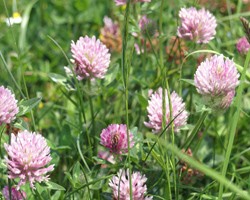Adding Cover Crops to Your Farm? Consider the Herbicide Rotation Restrictions
Darcy Telenko, Extension Vegetable Specialist
Cornell Vegetable Program
December 19, 2016

One challenge to adding cover crops to your vegetable production system is that herbicides with residual activity may interfere with cover crop establishment and growth. Residual herbicides are a key management tool in vegetable production, especially for management of difficult weeds and their potential to help control herbicide-resistant weeds. Some questions to consider when utilizing a cover crop and how well it will work with an herbicide program include:
- Will the cover crop be grazed or harvest for feed or forage? If yes, then the rotation restriction on the label must be followed to protect the food chain from pesticide residues and/or crop from injury. If a crop is not on the label, then the rotation restriction for "other crops" must be followed.
- How sensitive is the cover crop to herbicide carryover? Research has found that radish seems to be one of the most sensitive crops, while cereal rye and hairy vetch were the least. Residual herbicides with grass activity can interfere with establishment of some grass cover crops, while others can interfere with some broadleaf cover crops species. So it will all depend on the herbicide used and cover crop species being planted.
- How long can I expect the herbicide to remain active in the soil? There is great variability on persistence of herbicides in the soil, many labels will contain specific rotation restrictions. Herbicides with soil activity and a relatively long half-life include: Atrazine (60 days), Stinger (40 days), Pursuit (60-90 days) are a few examples.
- When was the herbicide applied and when do I plan to seed the cover crop? Much research has been conducted on residual herbicides and fall-seeded cover crop. It is expected that the longer the time period between herbicide application and cover crop seeding the lower the risk to injury, but we may see a greater need of understanding our herbicide programs a may play an important role as we see changes in when cover crops are being seeded.
- Should I increase my cover crop seeding rate? Higher seeding rates may be an option if there is marginal sensitivity to the herbicide - but there's not guarantee it will result in a higher stand of the cover crop and can lead to higher cover crops costs.
- Can I use a postemergence herbicide after interseeding my cover crop? To minimize risk, only select herbicides that have crop and cover crop on herbicide label and follow application restrictions listed on label such as crop and weed sizes.
Sources: "Common Corn and Soybean Herbicides, Estimated Half-Lives, Cash Crop Restrictions and Their Potential to Injure Fall Cover Crops", Penn State Extension, Curran and Lingenfelter, 2012, available at: http://extension.psu.edu/plants/crops/soilmanagement/cover-crops/herbicidepersistence/herbicide-carryover-table
"Managing risk when using herbicides and cover crops in corn and soybean" Lizabeth Stahl, Extension Educator - Crops https://www.extension.umn.edu/agriculture/weeds/herbicides/docs/cover-crops-and-herbicides.pdf
Common Herbicides on Vegetables in NY and Considerations for Cover Crops, 8.5x11 (pdf; 436KB)
Common Herbicides on NY Vegetables and Considerations for Cover Crops, 11x17 (pdf; 385KB)

Upcoming Events
2025 Potato Advisory Meeting
December 16, 2025
Canandaigua, NY
Come hear the latest on insect pest control and fertility management in potatoes from Cornell University experts. Potato variety trial updates will be shared too. After lunch will be the Empire State Potato Grower's Meeting. 1.5 DEC credits in 10, 1a, and 23.
2026 Finger Lakes Produce Auction Winter Growers Meeting
January 8, 2026
Penn Yan, NY
At this vegetable grower-focused meeting, ag industry experts will discuss food safety, disease management in strawberries, the benefits of using cover crops, plus more. Two grower panel discussions will focus on pest management techniques and irrigation. DEC recertification credits offered in categories 10, 1a, 21, 22, 23, and 24.


































